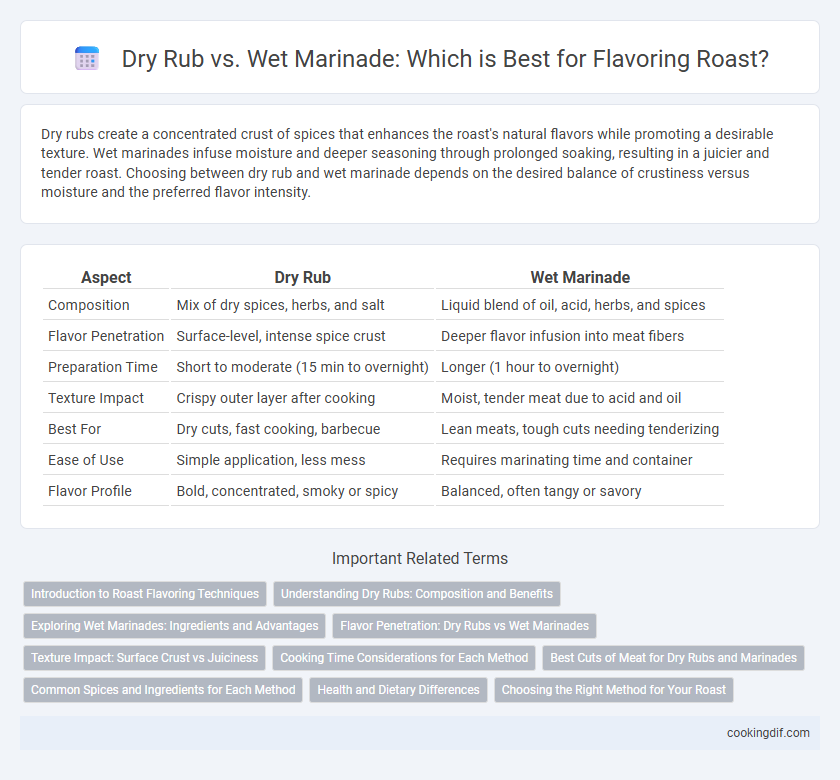Dry rubs create a concentrated crust of spices that enhances the roast's natural flavors while promoting a desirable texture. Wet marinades infuse moisture and deeper seasoning through prolonged soaking, resulting in a juicier and tender roast. Choosing between dry rub and wet marinade depends on the desired balance of crustiness versus moisture and the preferred flavor intensity.
Table of Comparison
| Aspect | Dry Rub | Wet Marinade |
|---|---|---|
| Composition | Mix of dry spices, herbs, and salt | Liquid blend of oil, acid, herbs, and spices |
| Flavor Penetration | Surface-level, intense spice crust | Deeper flavor infusion into meat fibers |
| Preparation Time | Short to moderate (15 min to overnight) | Longer (1 hour to overnight) |
| Texture Impact | Crispy outer layer after cooking | Moist, tender meat due to acid and oil |
| Best For | Dry cuts, fast cooking, barbecue | Lean meats, tough cuts needing tenderizing |
| Ease of Use | Simple application, less mess | Requires marinating time and container |
| Flavor Profile | Bold, concentrated, smoky or spicy | Balanced, often tangy or savory |
Introduction to Roast Flavoring Techniques
Dry rubs deliver intense, concentrated flavors by coating the roast with a blend of herbs and spices that form a flavorful crust during cooking. Wet marinades infuse moisture and depth by soaking the meat in seasoned liquids, enhancing tenderness and flavor penetration. Choosing between dry rub and wet marinade depends on desired texture, flavor intensity, and cooking method for optimal roast seasoning.
Understanding Dry Rubs: Composition and Benefits
Dry rubs consist of a blend of spices, herbs, and salt applied directly to the roast's surface, creating a concentrated layer of flavor that enhances the meat's natural taste. The absence of moisture in dry rubs allows for a crust to form during roasting, intensifying texture and caramelization through the Maillard reaction. This technique offers long-lasting seasoning benefits by penetrating the meat without diluting its juices, making dry rubs ideal for achieving a robust, savory roast flavor.
Exploring Wet Marinades: Ingredients and Advantages
Wet marinades for roast flavoring typically include acidic components such as vinegar, citrus juice, or wine combined with oils, herbs, and spices to tenderize meat and infuse deep flavor. The liquid base in wet marinades enhances moisture retention and allows for better absorption of aromatic compounds, resulting in a juicier, more flavorful roast. These marinades offer the advantage of breaking down muscle fibers more effectively than dry rubs, improving texture and overall taste complexity.
Flavor Penetration: Dry Rubs vs Wet Marinades
Dry rubs consist of a blend of spices and herbs that adhere to the roast's surface, creating a flavorful crust through direct contact during cooking. Wet marinades, containing acids and oils, penetrate deeper into the meat fibers, enhancing internal flavor and tenderness. Flavor penetration with wet marinades is typically more pronounced, while dry rubs provide a concentrated, textured seasoning on the outer layer.
Texture Impact: Surface Crust vs Juiciness
Dry rubs create a robust, textured surface crust by drawing moisture out of the meat, intensifying flavor concentration and forming a crunchy exterior. Wet marinades, infused with acids and oils, penetrate deeper into the meat, enhancing internal juiciness and tenderness without creating a crust. Selecting between dry rub and wet marinade significantly influences roast texture, balancing between crispy surface and succulence inside.
Cooking Time Considerations for Each Method
Dry rubs penetrate the roast surface quickly, allowing shorter marinating times typically ranging from 30 minutes to 2 hours, which makes them ideal for faster cooking schedules. Wet marinades require longer soaking periods, often 4 to 24 hours, to fully infuse flavors and tenderize the meat, significantly affecting overall preparation time. Choosing between dry rub and wet marinade impacts not only flavor intensity but also the total cooking and resting time needed for optimal roast results.
Best Cuts of Meat for Dry Rubs and Marinades
Dry rubs enhance the flavor and texture of tougher cuts like brisket, pork shoulder, and short ribs by creating a flavorful crust during roasting. Wet marinades penetrate well in leaner, more tender cuts such as chicken breasts, pork loin, and flank steak, adding moisture and subtle infused flavors. Choosing the right seasoning method depends on the meat cut's fat content and texture to optimize taste and juiciness in the final roast.
Common Spices and Ingredients for Each Method
Dry rubs for roast flavoring typically include spices like paprika, cumin, garlic powder, onion powder, black pepper, and brown sugar to create a bold, concentrated crust. Wet marinades often combine acidic ingredients such as vinegar, citrus juice, or wine with herbs like rosemary, thyme, garlic, and spices like chili flakes to tenderize and infuse the meat with moisture and layered flavors. Both methods enhance roast flavor by leveraging complementary spice blends tailored to dry or moist application, maximizing taste penetration and texture.
Health and Dietary Differences
Dry rubs typically contain a blend of herbs, spices, and salt with minimal added sugars or oils, making them a lower-calorie option that supports sodium and sugar control in diets. Wet marinades often include acidic components like vinegar or citrus juice combined with oils, which may increase calorie content and fat intake but can also enhance nutrient absorption and tenderness. Choosing between dry rub and wet marinade depends on dietary goals, such as reducing sodium and sugar for heart health or incorporating healthy fats for better nutrient assimilation.
Choosing the Right Method for Your Roast
Dry rubs create a concentrated, flavorful crust by directly applying a blend of herbs and spices to the roast, enhancing texture and caramelization. Wet marinades infuse moisture and tenderize the meat through acidic or enzymatic ingredients, resulting in deeper flavor penetration and juiciness. Selecting the right method depends on the roast cut, desired texture, and cooking time, with dry rubs favoring quick, high-heat roasting and wet marinades ideal for longer, slow-cooked recipes.
Dry rub vs Wet marinade for roast flavoring Infographic

 cookingdif.com
cookingdif.com